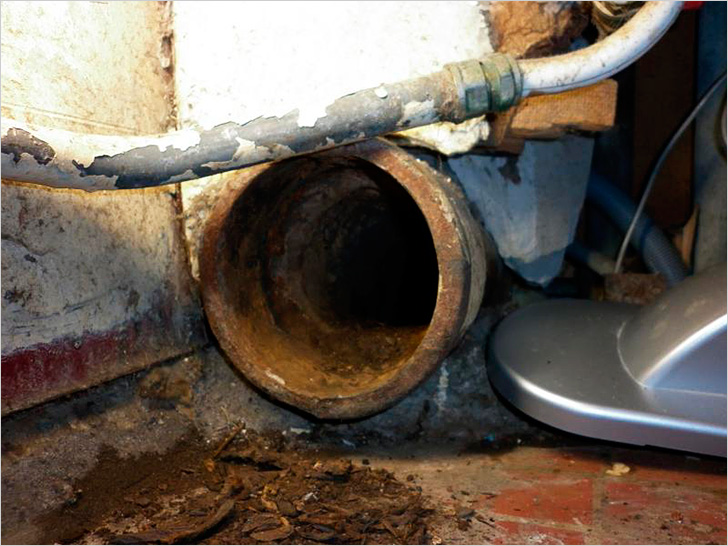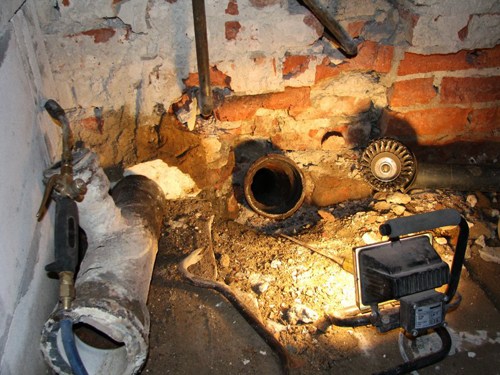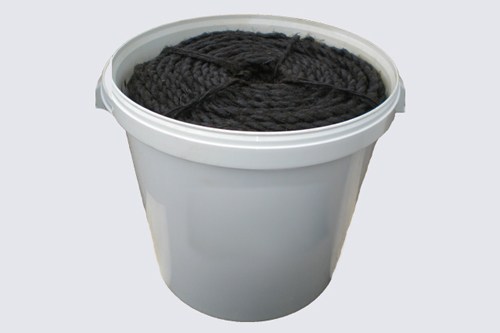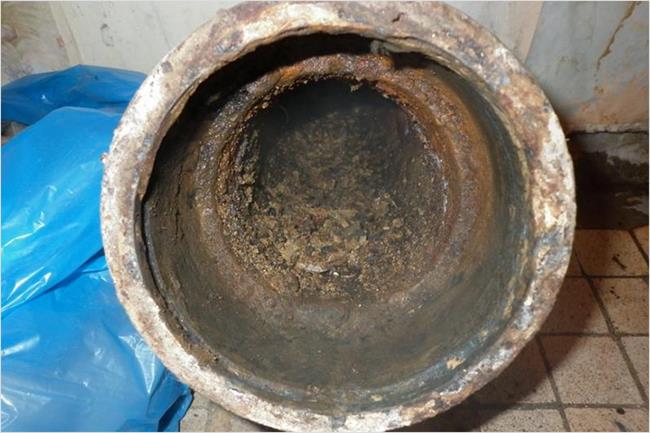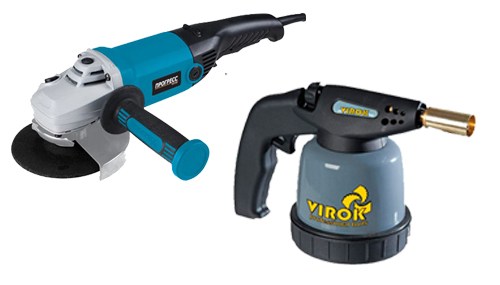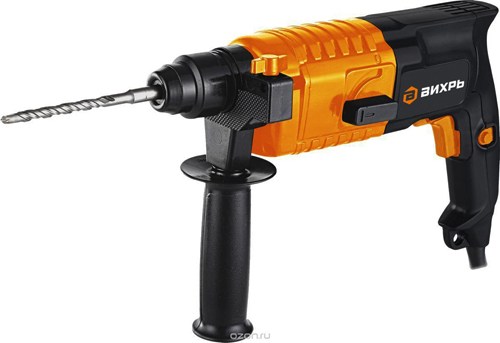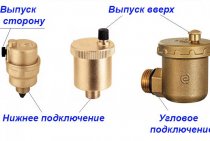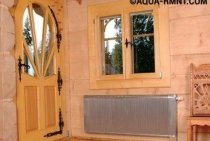Repair work on the street
If it becomes necessary to repair a cast-iron pipe that is placed on the street, then you can use the same methods that were described above. However, it is desirable to make additional fixation of the joined cast-iron pipes so that deformations in the soil do not open cracks. If the pipe is adjacent to the septic tank, then the above methods may not work. The design of the septic tank is subject to seasonal fluctuations, and this can destroy the integrity of the repaired connection.
In this case, first of all, liquid glass is used, which is poured from above in large quantities with mastic, which is used for gluing joints in panel houses. In principle, the mastic on its own perfectly seals the cracks, therefore, if liquid glass is not available, then you can do without it. However, it is still better to seal with it, it is more reliable.
When repairing, many people try to replace all outdated communications at once. It turns out that the most difficult thing to work with is cast iron sewer pipes that need to be dismantled. Previously, they were connected using cement, sulfur or aluminum. It turns out that the system was carried out for centuries. But now the end of the century has come. And with that, the hard work begins.
At first glance, it may seem that removing cast iron pipes is very easy. But here you need to work smart. Indeed, by applying too much force, you can damage the riser, which combines several apartments at once. In this case, the anger of the neighbors is inevitable. Costs, time and a lot of work will begin.
Before you start dismantling the old cast-iron pipe, you need to familiarize yourself with some rules:
- turn off the water supply in the house;
- remove the hose from the flush tank on the toilet;
- clean the toilet carefully;
- remove from the premises all devices and objects that may interfere with the performance of work;
- cast iron is a brittle material. Pipes that are far from the riser can be broken with a hammer;
- removal of pipes that directly fit the riser;
- cuffs are installed on the bell. First, the socket is cleaned of lubricants.
Dismantling instructions
It is best to start work on the dismantling of pipes that are located remotely from the riser. Here, a hammer and chisel will help to get the job done very quickly, since cast iron is a material that is brittle and cannot withstand blows.
It is important to use a rubber hammer or with a polymer nozzle. A steel hammer will crush the cast iron into small pieces that can fall into the riser.
Further, a congestion will begin to form there, which will be very difficult to eliminate.
Work with a hammer and chisel continues until it comes to the tee, which leads to the riser. Then you can try to loosen the cross by hand. But you can completely leave the section of the cross. However, experts recommend removing cast iron from the house to the maximum.
Work on heating pipes is carried out quickly by two people. One person can heat the pipes with a lamp, and the other can remove the softened sulfur with a knife. When a large amount of sulfur is removed from the pipes, the cross will easily separate from the riser. If it is not possible to completely pull out the tee, it can be cut off with a grinder. The main thing is not to damage the riser.
How to dismantle a cast iron pipe
If the pipe is “welded” to the wall or floor with sulfur or aluminum, it will be very, very difficult to destroy such a coating.
To get started, you must first turn off the water supply to the apartment. Then you need to free the bathroom from unnecessary items that you can damage during work. This includes a sink, washing machine, laundry basket, and more.
Next, you need to disconnect the drain tank from the water supply and dismantle the toilet bowl itself.Problems can also arise here, since Soviet toilets were screwed to the floor to the conscience, in other words, tightly.
Try to unscrew the bolts that attach the toilet to the floor and remove it from its place. If you succeed, consider yourself half done.
Now comes the turn of the pipes themselves. Cast iron, as you know, does not differ in particular strength, therefore, at some distance from the riser, you can simply break the old pipe with a hammer. It is much more difficult to remove the remnants of pipes from the old riser and clean them before installing new ones.
To dismantle pipes, you may need:
- Hammer with rubber or plastic tip.
- Chisel
- Burner or blowtorch
- Mask
Quite a strange combination, isn't it? However, a gas mask is necessary to comply with safety regulations if the joints of the sewer pipes in your bathroom are filled with sulfur.
The easiest way to remove sulfur is to heat it. However, when heated, the sulfur mass releases toxic substances into the air, which are extremely harmful to a person inhaling. That is why it is better to protect yourself in advance with a gas mask.
So, dismantling must begin at the place of greatest distance from the riser. Here, most craftsmen do not suffer with a burner, but simply break the pipe with a hammer. This is much easier, but can cause some complications.
Make sure that pieces of pipe do not fall into the sewer passage when broken. They can cause a serious blockage in the sewer, which will be much more difficult to get rid of than getting rid of old pipes.
With a hammer, you can destroy the pipe to the very cross, inserted into the riser. Here it is somewhat different and filled with gray much more.
To free the pipe and cross from the layer of sulfur, you need to heat it. The impact of a burner or blowtorch can last for several hours, while harmful substances will be constantly released.
Before starting heating, isolate animals and households, cover furniture or other furnishings in the immediate vicinity of the riser, put on a gas mask.
During the heating process, you can easily chip off lumps of sulfur until the pipe is sufficiently clean. Now, the cross, inserted into the riser, must, if possible, be loosened and removed from the riser.
The dismantling of the old pipeline is carried out to the maximum. That is, pipes are removed as much as possible, and others are mounted in their place.
Connecting a new PVC pipe to an old cast iron riser will require some skill to work with. Please note that you must clean the junction as much as possible from the same sulfur and rust.
To facilitate the work, use a special coupling, which is specially designed for connecting cast iron pipe and PVC pipe.
If you have any questions, take a look at ours and ask them there. Our experts will help you understand the intricacies of good construction and repair.
The process of dismantling pipes connected with cement and cable
When discussing how to disassemble an old cast-iron sewer connected with cement, it is worth noting that the process is not much different from the above, but is safer.
This is explained by the fact that sulfur emits carbon monoxide during melting.
And it all starts with a cut of a certain part of the cast-iron pipe, for which you need to step back from the separation points by about 30 cm.
The hardened cement is knocked down with a hammer, which needs to be beaten on a screwdriver inserted into the hole.
Dismantling the connection with cement and cable
It is important to know that you should not rush into this matter, because you can damage the bell. After breaking the cement at the joints:
After breaking the cement at the joints:
- you should try to loosen the main pipe. If you are interested in how to disassemble a cast-iron sewer without heating, then know that it is allowed to remove the cable;
- if even without a cable it is not possible to loosen the pipe, then strong heating or a special key will help. For example, for pipes with a diameter of 50 mm, you need tool No. 3, No. 4, but for a tee, you need another pipe.
Replacement of water and sewer pipes is usually necessary when the system is partially or completely worn out. And if a decision is made to carry out technical work without the participation of professionals, then you need to prepare in advance and know how to independently dismantle the sewer.
Do-it-yourself repair work is dangerous because even when replacing a worn part, there is a possibility that the leak will reappear. As a result, if the sewer pipes do not inspire confidence, it is better to change the entire system completely. But before that, it is necessary to dismantle the sewer.
By replacing pipes, it is possible to completely change the system of their location, especially since today materials allow this to be done without any problems. Modern materials, for example, pipes made of metal-plastic are more reliable, durable and durable than cast iron, and most importantly, sewer pipes are installed quite quickly and relatively simply.
Replacing the entire riser, it would be more appropriate to change all the plumbing and taps that are on the equipment. In addition, when you can change the entire route of the old collector run. In this case, it is necessary to strictly observe the correct slope and diameter of the pipes.
Repair work on the street
If it becomes necessary to repair a cast-iron pipe that is placed on the street, then you can use the same methods that were described above. However, it is desirable to make additional fixation of the joined cast-iron pipes so that deformations in the soil do not open cracks. If the pipe is adjacent to the septic tank, then the above methods may not work. The design of the septic tank is subject to seasonal fluctuations, and this can destroy the integrity of the repaired connection.
In this case, first of all, liquid glass is used, which is poured from above in large quantities with mastic, which is used for gluing joints in panel houses. In principle, the mastic on its own perfectly seals the cracks, therefore, if liquid glass is not available, then you can do without it. However, it is still better to seal with it, it is more reliable.
Almost all Soviet buildings are equipped with cast-iron sewer communications, since such pipes are durable and resistant to wear. But the cast iron pipeline requires the right approach to use and dismantling.
Unlike drain pipes, which can last for decades, connections inside a home may need to be replaced sooner. Also, interventions in the sewer system may be forced during the installation of washing equipment or redevelopment of the bathroom. To do it according to the rules, it is not necessary to call and wait for the master, all the work can be mastered by the owner himself, if he knows how to handle elementary tools. Dismantling the sewer should not take much time, but dismantling old products is more difficult. Let's figure out how to properly dismantle cast iron pipes.
Chasing a cast iron pipe
To chisel a cement-coated sewer pipe, remove the seal with a special hammer. Strong blows are unacceptable, the cement is chipped in small pieces. After that, the edge of the cable is searched (a rope wrapped around the pipe to enhance tightness) and an attempt is made to unwind it. There is no need to pull out the entire cable, it is enough to slightly free up space and loosen the cast-iron pipe entering the socket. It is most convenient to pull out the rope with a hook, if there is an opportunity (free space), then a screwdriver is squeezed into the gap between the socket and the nozzle.Only after the pipe begins to sway is it allowed to pull the cast-iron pipe out of the socket. To do this, it is pulled back in the transverse direction and scrolls in the end.
- pipes have grown together during operation;
- for sealing, they used not a cable with cement, but sulfur.
The remains are carefully chipped off with a chisel, it is important to avoid getting metal elements into the sewer. After that, the inside of the bell is cleaned and wiped dry with a rag
It is more difficult to disassemble sewer cast-iron pipes with a sulfur plug, heat treatment of the joint area is required - heating with a blowtorch to several hundred ° C, the desired state is determined visually (the pipe will turn red). In this case, the sealant burns out and the pipe becomes free. An important nuance: it is allowed to remove the cast-iron sewer pipe no earlier than 15 minutes after heating, it is impossible to loosen and influence hot joints.
As in the case of caulking pipes with a cable, blows to the pipes are not allowed, the pipe that has become unusable is carefully unscrewed (without effort and pressure).
The toilet is replaced according to the same rules. It is recommended to disconnect the water supply, drain the tank to the maximum and. When fastened with studs or a nut connection, it is easier to replace the toilet bowl with your own hands: it is unscrewed, loosened and removed from the outlet pipe. It is almost impossible to remove the toilet bowl installed on the cement mortar intact, in this case it simply breaks.
It is strictly forbidden to hit the sewer pipe, this is the same as directly hitting cast iron with a sledgehammer. Therefore, blows are applied to the neck, and then the toilet bowl is broken into pieces. At the moment the base is detached, water flows out of it, it is advisable to prepare rags and a bucket in advance to collect it. Be sure to clean the edges of the sewer cast-iron pipe from pieces of faience. This is done with a chisel or screwdrivers, this stage is very important (the pipe goes into the floor, problems arise if it is damaged). In the area of \u200b\u200bspecial risk are common risers with tees (c) and old toilets with cemented joints, in this case it is better to entrust the caulking to specialists.
WATCH VIDEO
The most difficult step when replacing an old pipeline is the dismantling of a cast-iron pipe that has served its purpose. Previously, in the construction of communications, cast iron pipes were used, the connection of which took place with cement mortar, sulfur or aluminum. Pipelines assembled using the last two substances are very difficult to destroy, so you need to prepare for lengthy dismantling work. And this article will tell you about the technology for their implementation.
Dismantling the riser
The following rules must be observed when disconnecting a vertical sewer pipe:
- management services are notified, permission is issued for repair work;
- riser users living upstairs are notified;
- repair operations are underway.
The presence of a compensator allows you to shift the product in one direction or another up to 10 cm. It must be remembered that the vertical structure has a certain mass. Therefore, it needs to be fixed.
The joints are treated with machine oil. By performing rotational-translational movements, the part is removed from the overall structure. The absence of a compensator forces one to resort to radical methods - to cut the fan pipe.
PVC plastic sewer pipes are processed by most locksmith tools:
- a hacksaw with a small hardened tooth;
- hacksaw for metal;
- file;
- sharp and durable knife and other tools.
Mechanized device - grinder, reciprocating saw.
When carrying out work, it is required to pay attention to the presence of a number of other communication elements:
- penstock;
- electrical system cable;
- storm drain.
Sewer pipe connections that have served for 10 years or more can “stick”, “grow” to each other. A number of recommendations can help in such cases;
- treatment of the junction with WD-40 lubricant;
- wrap sandpaper around the pipe; make rotational movements through it - the hands will not slip, the circular force will increase;
- if the product is scrapped, then it is necessary to make a through hole across the part; inserting a tube or a metal rod, we get a lever;
- apply the "barbaric" method of dismantling - cut the pipe into pieces, break it into pieces.
The methods for separating the parts of PVC pipes used for outdoor piping are exactly the same. But, it is necessary to determine the location of the damage and carry out earthworks.
How and what methods of undocking pipes - to choose the owner of the housing or invited experts. The main thing is to determine the feasibility of one or another method of dismantling faulty parts.
Something, but there was a lot of cast iron in the Soviet Union! All technologies were developed taking into account the use of this particular material. So in the laying of sewers, cast iron is still very much in demand. Of course, cast iron has many very significant advantages - it can withstand heavy loads, which allows you to assemble risers on many floors, it is durable, can perform its function for decades in damp or cold rooms, paint fits well on a cast-iron pipe, that is, it can be beautifully entered into design. In a word, a cast iron sewer pipe is a solid, durable thing. But in this thoroughness lies its main drawback. It is very difficult to disassemble, if necessary, a part of such a pipeline. And sometimes this is an urgent need. For example, you need an additional outlet or an existing outlet has become unusable. How to proceed?
The best thing is when the work is done by a professional, a master of his craft. In this case, you can be sure of the quality and efficiency of the work performed. But this option is not always possible. Often, plumbing has to wait for weeks, and their prices, to put it mildly, are overpriced. It happens that this "master" has no experience in such works. Not all those who wear plumbing overalls are such.
Sewer repair
Repair of cast-iron sewers is often performed in "old-fashioned" ways. However, modern repair methods are much more effective. If a small crack or chip appears on the pipes, then it will be enough to use a bandage, a jar of liquid glass and cement. To begin with, the surface is prepared according to the standard procedure (cleaning and degreasing). Next, liquid glass and cement are mixed until a thick mass is obtained. The finished mixture is smeared on the pipe and wrapped in a bandage, with each turn being treated with a mixture.
If the crack on the pipe went from above, then you can apply a rubber bandage in the longitudinal direction. The overlap is bent and pulled together with two clamps. If there is a financial opportunity, then you can fill the entire surface with silicone. Silicone will be effective for a while, but since it is not designed to be applied over large areas and has poor adhesion to cast iron, it will not be useful for a long time.
Sewer system
Using a grinder, the pipe adjacent to the tee is cut off at a distance of not less than 10 cm from the socket of the riser.
Dismantling of cast iron sewer pipes begins with the dismantling of the riser. When doing these works with your own hands, you should be aware that previously cement-based solutions were used to perform sealing. These compounds only get stronger over time. As a result, dismantling the old sewer system can bring a lot of trouble.
The most difficult can be the replacement of the riser.After all, in the good old days, masters filled with sulfur. To liquefy such solutions, a gas burner or a blowtorch is needed. When burning, sulfur solutions release harmful vapors into the atmosphere, so the use of a respirator by workers in such cases is simply a necessity.
This can lead to damage to the elements located in the adjoining apartments above and below.
It follows from this that it is better to change pipes for all neighbors in the riser at once.
Dismantling of sewer pipes specialists perform in the following order:
- cast iron pipes are cut with a grinder;
- first, 2 cuts are made horizontally, and the distance between them should be approximately 10 cm;
- using a chisel, break out and remove pieces;
- the tee is dismantled;
- disassembly of the rest of the pipe.
Removing the cast iron pipe
The dismantling of the riser begins with the removal, located between the tee and the ceiling. First, an annular gap is made on top of the section. To do this, at a distance of 12-16 cm from the ceiling, using a grinder, a cut is made in the pipe with the rest of the wall of about 3-5 cm.
An incomplete cut is needed to prevent jamming of the tool with a possible vertical movement of the column. Then, stepping back 9-13 cm down, a similar cut is made, parallel to the first. The ring between the cuts is carefully knocked out with a hammer or wedges.
The next step is sawing the cast iron section from the bottom. For its implementation, an incomplete cut by a grinder is made at a height of 50-70 cm from the upper socket of the tee. The clamps securing the section to the wall are removed (they can simply be cut off with a grinder). The pipe is broken by swinging or hitting with a hammer at the place of incomplete cut and removed from the column.
Tee dismantling
The most important operation of the entire dismantling of the old sewage system is the removal of the tee from the socket of the lower section of the riser
As noted, there is an important condition: this bell must not be damaged. The simplest dismantling options are used when filling the joint with cement mortar
First, an attempt is made to separate by loosening.
A crowbar is placed in the hole of the rest of the pipe, with its help bending forces are created in different directions. Most often, such loosening destroys the cement bond, and the tee can be removed from the lower socket. When the joint is destroyed, the ingress of large cement pieces into the pipe should be eliminated, that is, the cement is removed from the socket with a screwdriver or chisel.
If loosening did not lead to a positive result, then a more time-consuming method will have to be applied: the cement mass is destroyed with a chisel and a hammer
Given the brittleness of cast iron, this procedure should be carried out very carefully, and the impact force should be applied away from the walls of the socket. The goal is to provide a gap between the tee pipe and the socket walls
As the cement pieces break off, they are immediately removed from the joint area.
The most difficult method of dismantling has to be used when filling the joint with sulfur. Such a composition is very durable and does not lend itself to the destruction methods described above. In this case, heating of the joint area is most often used with a gas burner or a blowtorch. The work is carried out by two people. One worker warms up the joint, and the other loosens the tee.
When the mass is melted, the tee is easily removed from the socket
Such work takes place when very harmful gases are released, which means that precautions must be taken (respirator and goggles)
Finally, extreme circumstances may arise when it is not possible to remove the tee from the lower section in any way (it is impossible to use heating, especially strong pouring and other non-standard situations). In this case, the most undesirable option is used - the tee is cut off at a height of about 5-6 cm from the socket.The end of the rest of the pipe is carefully aligned, and subsequently, when installing plastic pipes, you will have to use a coupling.
If the installation of new plastic sewer pipes is planned, then it is impossible to do without the rather laborious dismantling of the old cast-iron sewer. This process can cause a number of difficulties, so you should prepare in advance to solve problems that arise.
When a person makes major repairs in his apartment, then such a type of work as replacing the sewer system is one of the main ones. This is due to the fact that in most cases cast-iron pipes are installed in residential premises.
Which tool will be used to dismantle the sewer elements with your own hands depends on the material used for embossing.
Basically on hand should be:
Caulking tool
- grinder - used to cut a piece of pipe;
- cutting, grinding discs;
- protective mask, goggles, headgear (in case of chasing pipes connected with sulfur);
- blowtorch - required for heating;
- hammer, screwdrivers of various lengths and thicknesses;
- pipe wrench;
- chisel.
Bulgarian and blowtorch
If you are dealing with cast iron elements, then the arsenal should include: a puncher, a chisel / steel wedge, a crowbar or a nail puller, a pipe cutter, an iron bucket filled with water.
Before you start work, it does not hurt to draw up an action plan, which depends on how the sewer pipes are connected.
Perforator
We disassemble the internal wiring
This step usually takes the least time. It makes no sense to keep the pipeline inside the apartment intact, so it does not need to be disassembled. It is enough just to cut off the outlet leading to the bath, sink and other plumbing with a grinder, and then saw or split it into smaller pieces and take it out of the apartment.
We dismantle the riser
Dismantling the riser must be carried out with extreme caution. First of all, you need to make a couple of horizontal cuts in the upper part of the pipe, at a distance of 10-15 cm from the ceiling
It is not necessary to cut the pipe completely, it is better to leave a 3–5 cm section intact. Then carefully knock out the ring that has turned out between the cuts with a sledgehammer.
Next, the section is sawn from below at a distance of about half a meter from the tee / cross. After that, remove the clamps with which the pipe is attached to the wall. Then the section is chipped off along the saw line, removed from its place and removed from the room.
Analysis of the tee
The procedure for dismantling the tee / cross will depend on how its joint with the lower section of the sewer pipe is sealed. If cement is used as a sealant, the fan outlet is carefully loosened with a crowbar. In the process, you can try to break off and remove small pieces of cement putty with a narrow screwdriver. If the layer of cement is very thick, it is knocked down with a hammer and chisel. After removing the bulk of the putty, the cross is carefully removed from the socket.
If the tee is sealed with sulfur, to remove it, it is necessary to heat it for a long time with a blowtorch or a hair dryer. During the heating process, the sulfur putty will melt. The branch must be constantly loosened a little to speed up the melting process. As soon as possible, it is removed from the socket.
If the fan branch does not lend itself to any manipulation, it is simply cut off by a grinder at a distance of 5-6 cm from the lower socket. The rest of the riser is then cleaned, and new pipes are attached to it using special adapters.
Repair of a broken sewer system. The caulking technology depends on the method of joining the joints (type of filling): cement ones are carefully broken with a hammer, gray is heated with a blowtorch. all its virtues, refers to brittle materials and breaks under the direct application of force.
Moments of dismantling cast iron
With a complete replacement of the structure with a plastic one, you can not do extra work and just smash everything with a hammer. This is quite easy to do, because cast iron is considered a brittle material.However, if only part of the pipeline needs to be dismantled, the work must be done more carefully.
Before dismantling the cast-iron sewer, it is necessary to inspect the entire system to determine the area that will be repaired. Then be sure to turn off the water supply so that the drains do not enter the sewer. Further disassembly is carried out in stages:
- The part of the pipe located below the connection is cut off.
- The pipe is separated from the socket. The embossing methods will be discussed in more detail.
- If you remove the connection just does not come out, use a blowtorch or make surrounding cuts 20 mm long.
When carrying out procedures, it is imperative to use all protective equipment due to the injury risk of this work.
Caulking of the pipeline with sulfur compound

- turn off the water;
- disconnect the hose leading to the toilet;
- remove the toilet itself by unscrewing the bolts;
- clean the bathroom of appliances and furniture.
To determine whether sulfur was really used when connecting pipes, you need to bring a blowtorch to the seam. Under the influence of high temperatures, sulfur melts, accompanying this process with an unpleasant odor.
When disassembling cast-iron sewer pipes, work begins from the farthest corner. The element must be broken with a hammer. It is better to use a tool with a plastic or polymer base, because the sewer can become clogged due to metal nozzles. Having found the cross leading to the riser, it is necessary to loosen it as much as possible.
Then you need to prepare a blowtorch or gas burner. At least two people should be involved in heating up the connections. While one warms up and melts sulfur, the other must loosen the structure. When doing this, be sure to use gloves and other protective equipment.
When the connecting substance is completely melted, the crosspiece can be removed from the riser. At the same time, you should be very careful, you need to remember to remove the remaining sulfur, and then let the riser cool thoroughly. If the cast iron structure is too strong, you can always make a few cuts near the pipe that needs to be removed. This will make the extraction process easier.
Cement bonded pipeline caulking
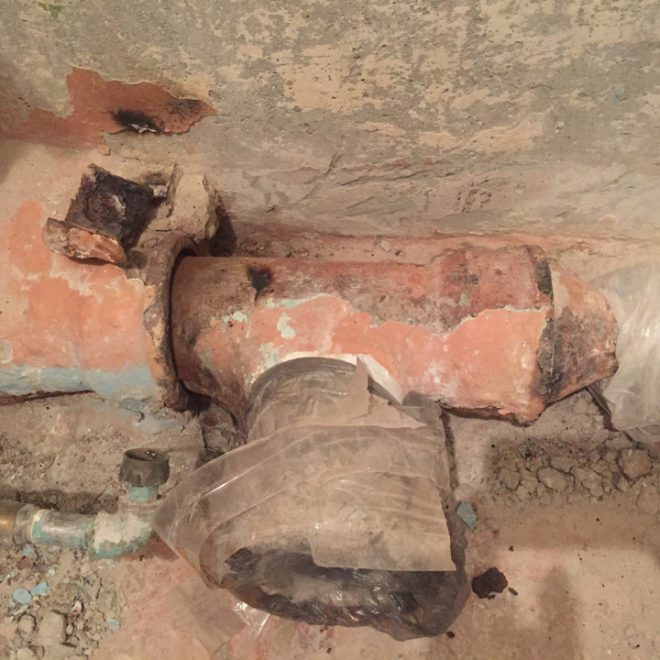
To start dismantling, you need to cut off part of the pipe. In this case, it is worth retreating at least 30 cm from the junction. The hardened cement is removed with a hammer, which must be beaten with a screwdriver or a chisel inserted into the hole. All procedures should be performed as carefully as possible so as not to damage the socket.
When the joints are freed from cement, you need to try to loosen the main pipe. In order not to process the sewer with a blowtorch or a burner, it is necessary to remove the cable, but if this cannot be dispensed with, it is necessary to heat it up strongly or use a specialized key. For example, for a 50 mm pipe, tool Nos. 3 and 4 are used.
The crosspiece is located below on the main riser. To remove it, you can simply use a hammer with a screwdriver. At the same time, for some time, you need to lightly tap on the tee itself in order to form a small gap between it and the pipe. Then you need to penetrate this opening, pry off the tee and remove it. It will take a lot of time to carry out these manipulations, in addition, this method is ineffective.
The next option is to use a blowtorch or burner.Dismantling is much faster, but the price for this is an unpleasant smell that takes a long time to disappear. First of all, you need to cut the socket of the cross. Then a heating device is placed in the pipe. A metal shield is applied to the upper part of the pipe in order to be able to regulate the draft inside the riser. When heated, you need to start swinging the pipe and, as soon as possible, remove the dismantled tee.
You can also use a grinder. To do this, you must first cut off parts of the tee, leaving a small piece in the pipe. Then put a medium-sized disk that could freely get inside, and cut through the remaining parts of the structure with a grinder, knocking them out with a hammer.
Tools and materials
When buying the required materials, it is necessary to pay attention mainly to their quality, and not to the price (as many people do). Unnecessary savings and the use of cheap, low-quality materials often go sideways in the future.
It is necessary to make sure in advance that all purchased equipment is not subject to corrosion and is resistant to mechanical damage.
To remove worn sewer pipes, you will need:
- pencil for marking;
- Bulgarian;
- hammer;
- chisel;
- sealant;
- cement mortar.
Materials that may be useful:
- rubber cuffs for fastening pipes in sockets;
- pipes of the required diameter and required length;
- tees;
- compensators for joining sewer pipes;
- special adapters made of plastic;
- clamps for mounting pipes to the wall surface.
